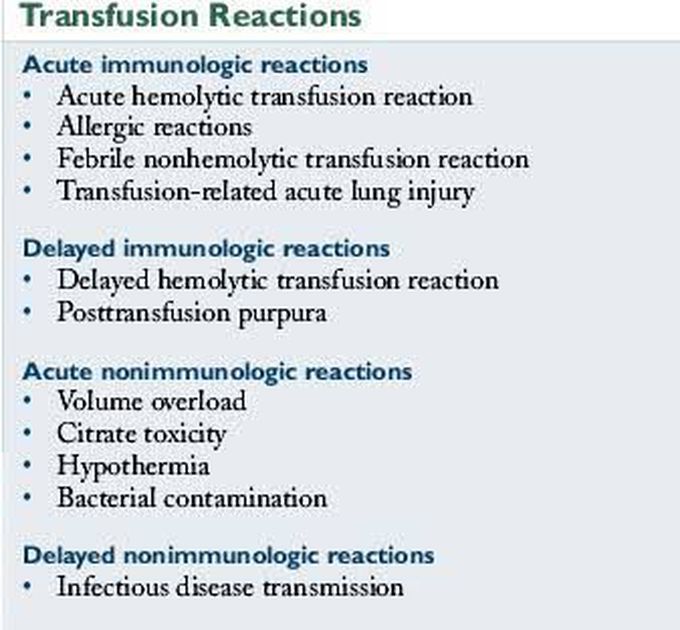


Causes of transfusion reactions
SUBSCRIBE Transfusion Reactions Medically reviewed by Darragh O'Carroll, MD — By Rachel Nall, MSN, CRNA and Krista Elkins, BA, RN, CRFN, NRP, CCP-C on May 6, 2022 What it is Process Symptoms Types and causes Lower your risk FAQs Takeaway If the blood type is not a match, you can experience a transfusion reaction. You can also have a transfusion reaction if you receive blood containing infectious microbes, if you experience an allergic reaction, or if you receive too much blood. Blood transfusions can be lifesaving in cases of blood loss. However, screening donated blood is important to ensure it goes to the right person. This article will discuss the various transfusion reaction types, symptoms, and treatments. What are transfusion reactions? If you’ve experienced severe blood loss or low blood levels, a blood transfusion can help restore the blood you’ve lost. Also knownTrusted Source as a hemolytic transfusion reaction, this routine procedure adds donated blood to your own as long as it’s accurately matched to your blood type. What is the transfusion process? Your doctor may recommend a blood transfusion if you’ve lost or are not producing enough blood. This can be due to the following: illness surgery cancer infection burns injury other medical conditions Blood transfusions are most commonlyTrusted Source done for blood components, such as red blood cells, platelets, or plasma. Before a blood transfusion, a healthcare professional will draw your blood. This sample will be sent to a laboratory for typing and crossmatching. Typing is when the lab determines blood type. Crossmatching is testing to determine if your blood is compatible with a donor’s blood of the same type. The blood types are: A positive A negative O positive O negative B positive B negative AB positive AB negative Knowing your blood type is important because red blood cells contain antigens, or protein markers, corresponding to these blood types. If a laboratory gives you the wrong type of blood, your immune system will detect any foreign proteins on the red blood cells of the wrong blood type and attempt to destroy themTrusted Source. Blood banks have thorough testing processes to make sureTrusted Source blood is safe and correctly typed for use. A doctor or nurse will explain any risksTrusted Source of blood transfusions and closely monitor you while receiving the blood. Symptoms of a transfusion reaction Blood transfusion reactions may occurTrusted Source while you’re receiving blood or immediately after. They may also occur hours, days, or weeks later. This is called a delayed transfusion reaction. Transfusion reactions may range in severity from minor to life threatening. A doctor or nurse will stay with you while you receive the transfusion. They will check your vital signs and watch for symptoms that you may be having a reaction to. Transfusion reaction symptoms may include: back pain dark urine chills fainting or dizziness fever flank pain skin flushing shortness of breath itching Pay close attention to your body after a blood transfusion, and contact a doctor if you feel something isn’t right. Types of transfusion reactions and their causes The following are the different types of transfusion reactions and what can cause them. Febrile non-hemolytic reaction This is one of the most commonTrusted Source types of transfusion reactions. It occurs during or up to 4 hours after a transfusion is completed. Symptoms fever chills Treatment As always, the first step in managing a transfusion reaction is to stop the transfusion. The symptoms are generally mild and respond well to treatment with antipyretics. Acute hemolytic reaction This occurs when antibodies in the recipient’s blood attack the donor’s blood if the two are not compatible. The prevalence of an acute hemolytic reaction from a blood transfusion is approximately 1 in 70,000 transfusionsTrusted Source. Symptoms fever flank pain red or brown urine low blood pressure Treatment The first step is to stop the transfusion. From there, treatment is mainly supportive. If the reaction is severe, in the case of low blood pressure, for example, aggressive resuscitation should be initiated. Allergic reaction You can have an allergic reaction to a blood transfusion as well. This occurs when the recipient’s immune system reacts to allergens or antigens in the donor’s blood. This type of transfusion reaction could also progress into a more severe allergic reaction known as anaphylaxis. Symptoms hives itching rash Treatment Again, the first step is to stop the transfusion. This reaction type is often treatedTrusted Source with antihistamines. If you are experiencing more severe symptoms like trouble breathing or swelling in your throat, your doctor may treat you with IV epinephrine, IV steroids, and bronchodilators. Transfusion-related acute lung injury (TRALI) This reaction may occurTrusted Source when donor plasma contains antibodies that cause damage to the immune cells in the lungs. This lung damage results in fluid buildup in the lungs and can severely limit the ability of the lungs to supply oxygen to the body. This reaction usually occurs within six hours of receiving blood. Symptoms fever shortness of breath low blood pressure Treatment Immediate treatment is to stop the infusion. Supportive management is aimed at improving oxygenation. Septic Sometimes, bacteria may be present in the donated blood. Giving this blood to a recipient can lead to infection, shock, and death. Bacterial contamination is the second most commonTrusted Source cause of blood transfusion-related deaths in the US. If not caught in time, it may lead to sepsis. Symptoms fever changes in blood pressure stiffness Treatment Your doctor will treat you with IV fluids and a course of antibiotics for this transfusion reaction. Transfusion-associated circulatory overload (TACO) A transfusion reaction can also occur if you receive too much blood. Having too much blood can overload your heart, forcing it to work harder to pump blood through your body and resulting in fluid buildup in the lungs. TACO and TRALI are the leading causesTrusted Source of transfusion-related deaths. Symptoms rapid heart rate rapid breathing shortness of breath high blood pressure bulging neck veins low blood oxygen Treatment The first line of treatment is to stop the transfusion. Sitting upright may improve your symptoms, or your doctor may need to administer IV diuretics in more severe cases.

